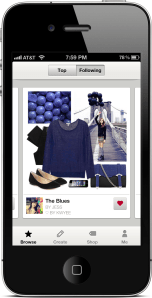Polyvore, the interactive fashion and style website that lets people create collages of apparel and accessories using images from any online store, has had solid growth since it first came on the scene back in 2007. Its monthly unique visitor count has steadily grown to more than 19 million, up from the 13 million monthly uniques it was seeing in the beginning of the year. And, most impressive by startup standards, Polyvore co-founders Jess Lee and Pasha Sadri tell me the 55-person company’s operations recently went beyond being merely profitable to hit cash flow positive status.
So it’s kind of surprising to hear that Polyvore has achieved this kind of scale all without having any native mobile apps. The company has seen a decent amount of traffic from its HTML5-powered mobile website, but having a native app for the iPhone especially has been an oft-requested feature from users for some time now.
Today that is finally being addressed. Polyvore just debuted its first-ever native app for the iPhone. Lee and Sadri swung by TechCrunch TV to talk about Polyvore’s latest growth and show off the brand new app, and you can watch all of that in the video embedded above.
 When seeing the app in action, the first impression is that this could really boost Polyvore’s participation and interaction even more. The touch-screen interface makes the collage-creating experience very natural — it lets you easily drag, drop, angle, and arrange images much in the same way that you would when creating an old fashioned paper collage. You can also use a pinching motion to quickly make an image larger or smaller. And when browsing other people’s collages, you can click through to buy items without leaving the app at all.
When seeing the app in action, the first impression is that this could really boost Polyvore’s participation and interaction even more. The touch-screen interface makes the collage-creating experience very natural — it lets you easily drag, drop, angle, and arrange images much in the same way that you would when creating an old fashioned paper collage. You can also use a pinching motion to quickly make an image larger or smaller. And when browsing other people’s collages, you can click through to buy items without leaving the app at all.
In all, the new iPhone app just seems like something that will encourage Polyvore fans to use the site more often and in more places than they already do.
Going forward into 2013, Lee and Sadri say that Polyvore will continue to focus on mobile by building tablet apps. The company is also looking to expand deliberately into more genres, such as home decor, which might help extend Polyvore’s reach into a slightly older demographic. The site’s primarily female user base has always had a strong representation of teenagers and young women, but in recent months Lee and Sadri tell me that Polyvore has grown so that now 25 percent of its users are in the 35 to 54 age range.
That’s an especially lucrative group in the eyes of marketers and advertisers, and converting user growth and activity into dollars is something that Polyvore has already shown it can do. It’ll be interesting to see how Polyvore continues to grow along with its user base in the months ahead — and what kind of strategic offers it might attract from larger companies looking to get an edge in the growing online style and fashion space.